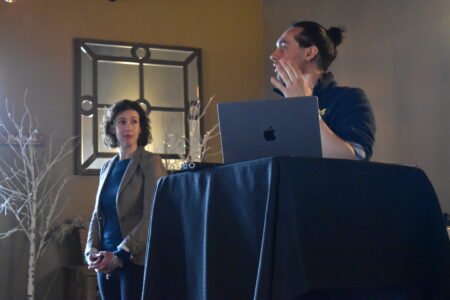13 stamp sand sites remediated at Torch Lake Superfund site
LAKE LINDEN – Torch Lake fish are looking better, but you should still think twice before eating them. Polluted stamp sands throughout the Keweenaw have been covered with topsoil and planted with grasses, but not much is growing on the floor of Torch Lake.
Torch Lake and the Copper Country have come a long way since mine-waste related environmental issues were recognized in the ’70s ad ’80s, but there’s also plenty of work to be done, agreed speakers at the Torch Lake Water Quality Meeting held Wednesday at Lake Linden-Hubbell High School.
The most visible progress is in the nearly 800 acres of Torch Lake, Lake Superior and Portage Waterway shoreline that were once covered in stamp sand, the mine tailings left over after mine rock was crushed and processed. Many stamp sands still contain a high copper content, which can leach into surrounding water or get picked up and spread by high winds.
“It’s not dangerous to humans but can be for fish at the bottom of the lake,” said Rob Aho, an engineer with the U.S. Department of Natural Resources Conservation Service who led the first large remediation project.
In 1986, Aho said, Torch Lake and surrounding stamp sand areas were placed on the U.S. Environmental Protection Agency’s National Priorities List, and in 1998 they allocated $15.2 million for cleanup, with the Michigan Department of Environmental Quality kicking in another $1.5 million.
The project designation as the Torch Lake Superfund Site is a bit misleading, Aho noted. While Torch Lake is probably the largest cleanup challenge, the project actually included 13 sites around the Copper Country. Some stamp sand sites were not included in the project for a variety of reasons.
“The Gay Sands are a classic example,” he said. “Keweenaw County wasn’t interested at the time.”
The remediation, Aho said, involved grading the sands, covering them with six inches of soil and vegetation, and planting legumes and grasses. They also worked on a few streams, cutting off stamp sands that were being sent to the lake.
The biggest project was the Mason Sands along Torch Lake, he said. The most prominent, though smaller, was the Quincy Smelter site on the Portage Waterway in Hancock. Most sites have been fully delisted by EPA, though a few, such as the North Entry site across from McLain State Park, are still being monitored prior to delisting.
The remediation has one unusual distinction for a government project, Aho noted.
“We came in under budget,” he said.


